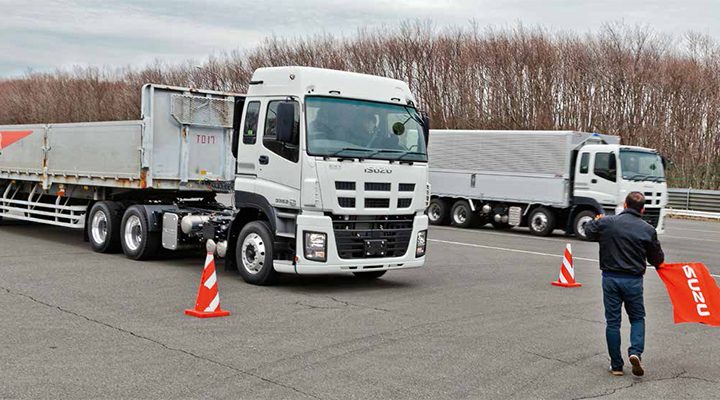
The updated and expanded Giga range offers Isuzu a larger slice of the heavy truck market.
Isuzu‘s dominant position in the New Zealand truck market for the past 15 years has largely been based around its highly successful N and F series trucks, which cover a multitude of applications from two to 15 tonnes payload. These have a well-founded reputation for reliability and long service life, usually in the hands of owners who see them purely as a means of getting a transport task done at the lowest overall cost.
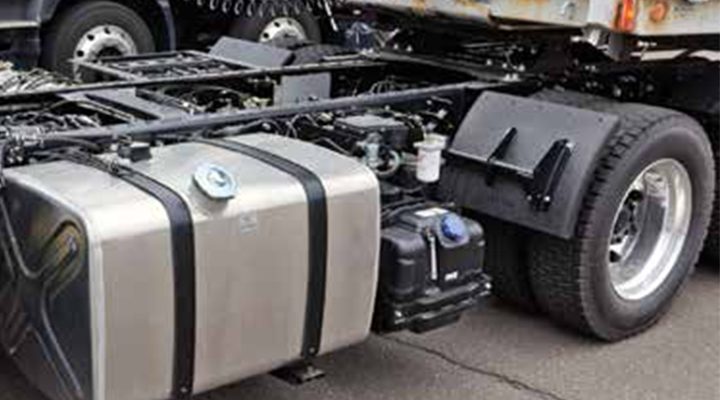
Diesel Emissions Fluid tanks are a feature of the new Giga range.
At the heavy end of the market, it has been a much harder battle with strong competition from European and American based brands as well as increasing requirements for gross combination weights over 50 tonnes. In common with most truck makers, Isuzu had problems with EGR engines and AMT boxes which cost them dearly in warranty costs and reputation.
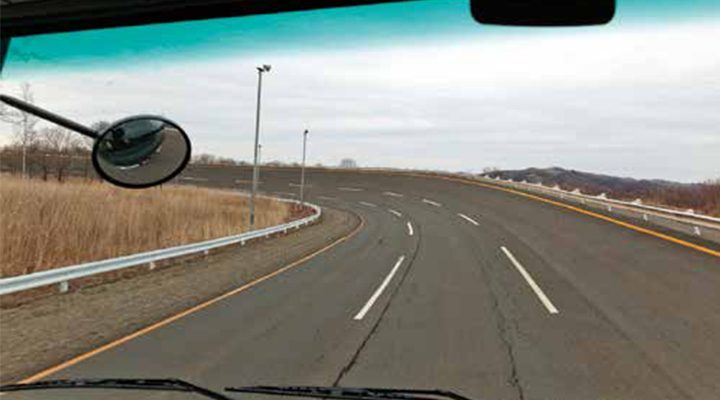
Driving around the steeply banked corners of the Hokkaido proving ground is, at first, an unnerving experience.
When we visited Japan, as part of a group of journalists invited to preview the new Giga range, it was evident that lessons had been learned and the unique requirements of the New Zealand market were being given much closer attention.
There are now 18 Giga models available ex factory, giving a choice of manual or AMT gearboxes, high roof and standard cabs, different chassis heights, wheelbases and axles. The two chassis heights allow Isuzu to compete with European manufacturers in height critical applications such as stock transport but offer the deeper profile preferred by logging and tipper operators.
We travelled to the WAcom proving ground near Mukawa on the island of Hokkaido, which is the most northerly part of Japan. If you thought Otago gets chilly, spare a thought for the locals up here where the average winter temperatures are around –4degC!
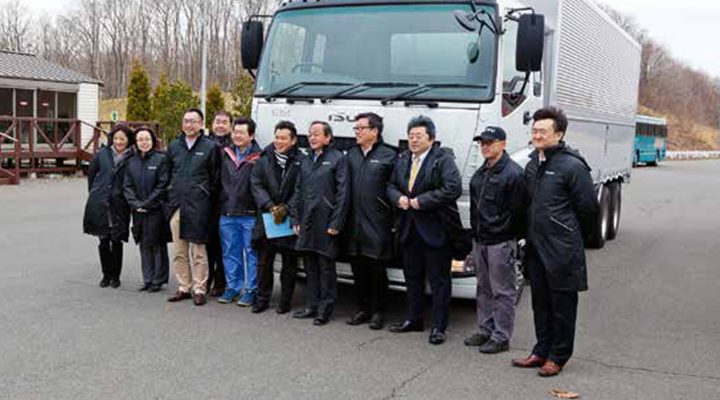
Isuzu‘s engineering staff pose bravely for a photo in the face of a freezing southerly wind.
The WAcom facility is Isuzu‘s main proving ground for new vehicles and after a welcome and introduction session given by their engineering staff we were taken to the test circuit where two pre-production Giga‘s were made available for test drives. The new series is codenamed VC36 and the key changes include Euro 5 engines with SCR emissions control and broader torque curve, increased cab height, upgraded cooling system plus the latest generation of Isuzu‘s 16-speed AMT box.
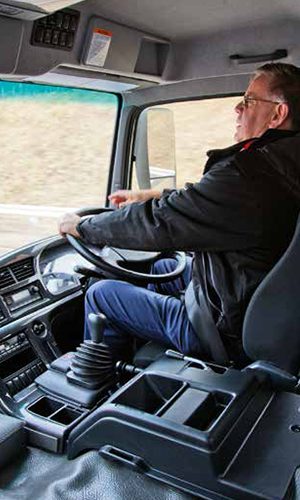 Giga has a well laid out cab and straight forward contols.
Giga has a well laid out cab and straight forward contols.
With a biting northern wind cutting through several layers of clothing, our immediate interest was quick cab access and how well the heater worked. The Giga CYJ 8×4 came up trumps in both regards. Once thawed, we quickly settled in the ISRI 6860 seat and found the main controls fell readily to hand. That is a key feature of the Isuzu range and valuable in a fixed fleet application where drivers may change vehicles on a regular basis. The fully suspended steel cab meets ECE29 crash test standards and has a bunk behind the seats that would be ideal for occasional nights out.
With 460hp from the big 15.7 litre six cylinder engine and the eight wheeler only loaded to 27 tonnes, performance was brisk off the mark and the AMT skip-shifted through the lower gears. Out on the track the broader torque characteristics of the SCR engine were evident with the ability to accelerate well in top gear from around 65kph. The 6WGI now features a flat torque curve from 1300rpm down to 900rpm which amounts to less gear changing and loss of momentum on hills.
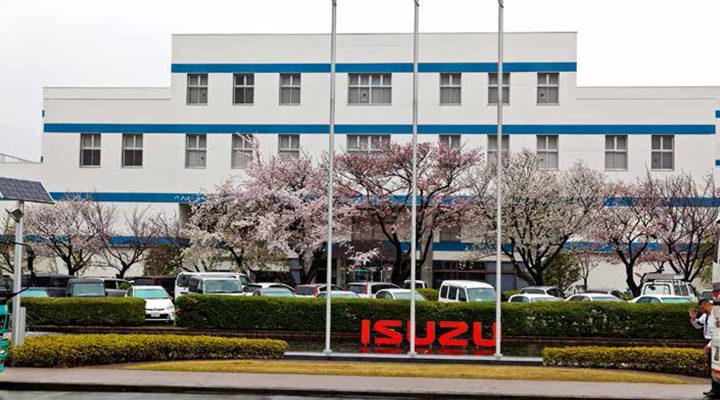
Isuzu‘s main Research and Development facilities are located within the vast Fujisawa plant near Yokohama.
At the time of our visit the transmission programming and axle ratios for New Zealand vehicles were still being finalised in light of on-road testing currently being carried out here. The scary part of being on the test track was taking the heavily banked (42deg) tight corners at 80kph, assured by my hosts that centrifugal force would take a loaded truck around without any steering input, which we‘re pleased to say it did.
The second test vehicle was a EXY 6×4 tractor unit coupled to a typical Japanese semi-trailer loaded to 37 tonnes gross; once again, performance was strong. With 530hp (JIS rating) and 2255Nm of torque, Isuzu is currently leading its Japanese competitors – Hino with 490hp (JIS) closely followed by UD with 476hp (JIS) and Fuso 470hp ( JIS). Currently is the operative word, and the stakes could be raised over the next couple of years. Doing this without affecting fuel economy or reliability is the real challenge but the increased height of the Giga cab suggests Isuzu is planning ahead.
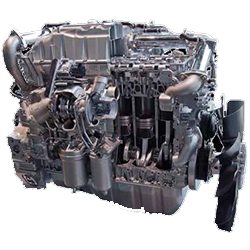 Selective Catalytic Reduction is replacing Exhaust Gas Recirculation on Isuzu’s Euro 5 engines.
Selective Catalytic Reduction is replacing Exhaust Gas Recirculation on Isuzu’s Euro 5 engines.
Neither of the test units was speed limited but sat comfortably and quietly on the 100kph recommended maximum speed for the test circuit, with the rev counter reading around 1700 rpm. Full air ABS drum brakes all round gave plenty of stopping power but the truck could also be quickly brought down to walking pace using the combined efforts of Isuzu‘s exhaust brake and magnetic retarder activated by a single stalk on the left hand side of the steering column.
The first click down on the stack engages the exhaust brake (350hp) and the second position adds the noticeable efforts of the magnetic retarder. On AMT models the transmission will automatically downshift where possible to assist braking whilst a thermal cut-out function disengages the retarder if its operating temperature exceeds 100degC.
Giga models are designed around much heavier gross weights than curre tly permitted in New Zealand and the units we tested reflected this. Some minor specification changes are expected following the local validation trials but for the New Zealand market the top GCM rating will be 58,000kg (6×4) and 62,000kg on some 8×4 models.
After our test drive session we were given a tour of the huge 440 hectare WAcom site where Isuzu and its competitors‘ trucks were being slowly beaten to death around the rough road and cross country circuits. Other sections of the complex feature steep grades and low friction surfaces where ABS and electronic stability control systems are tested.
While computer simulation and component analysis have speeded up the design process, the ultimate test is still to assemble a prototype truck and try to break it, and this is what the Hokkaido test facility is all about. Engineering failures here represent lessons learned but ultimately a more reliable product for the customer.
A thousand kilometres further south, at Isuzu‘s Research and Development facilities at Fujisawa, we saw the other climatic extremes, where full-sized trucks are tested in environmental test chambers capable of simulating ambiant temeratures up to 50degC, various levels of humidity and road surface temperatures up to 80degC. This testing seems to be a never-ending process,
with each round of environmental standards and specification upgrades throwing up new challenges for engineers.
Isuzu has been making diesel engines since 1936 and now produce over 850,000 per annum for automotive, earthmoving, marine and stationary applications. It has 132 engine test cells at Fujisawa where new designs and production samples are extensively tested under load.
The test cells are sound-proofed, can simulate different environmental conditions and incorporate a quick change cassette system which allows an engine changeover within 10 minutes. One cell is set up with a tilting framework which allows marine engines to be tested at various inclinations that a vessel may encounter in heavy seas.
The R+D facilities are located within Isuzu‘s giant Fujisawa production plant and the scale of this facility is most impressive. It occupies over 110 hectares, employs 7300 staff and turns out around 300,000 trucks per year, which are sold in 100 countries around the world. These vary from highly-developed Euro 6 markets such as Europe and the USA to developing countries like Kenya and Colombia where road conditions and working environments are much harsher. Shipments to New Zealand probably fall somewhere between those two extremes and are made once a month via the port of Yokohama, 25km away.
Larger vehicles are driven to the port while the smaller N series are carried on a transporter. The hospitality, extensive industry knowledge and open approach shown by senior Isuzu staff were clearly evident during our visit. Most have at least 20 years service with the company, are proud of their products but well aware of customer expectations and different local requirements across the globe.
New Zealand is seen as a small but challenging market for heavy trucks with recent increases in gross vehicle mass and long distances covered over difficult terrain. The New Zealand heavy truck market now seems to be dividing into two sectors – those who want maximum power and features regardless of price versus the more cautious business folk who keep a tighter rein on the purse strings but still want to haul maximum loads.
The latter camp is where fleet sales are going to be made and Isuzu New Zealand General Manager, Colin Muir is upbeat about the prospects of the new Giga range. He points to a raft of mechanical improvements and forward orders for 45 units to date from local customers.
Isuzu didn‘t get to be number one in the light and medium duty markets without a lot of hard yards from its engineering, manufacturing, sales staff and dealers and it is now in a position to achieve the same with heavy duty trucks. The new VC36 Giga is a more refined and better suited offering for the New Zealand heavy truck buyer.




